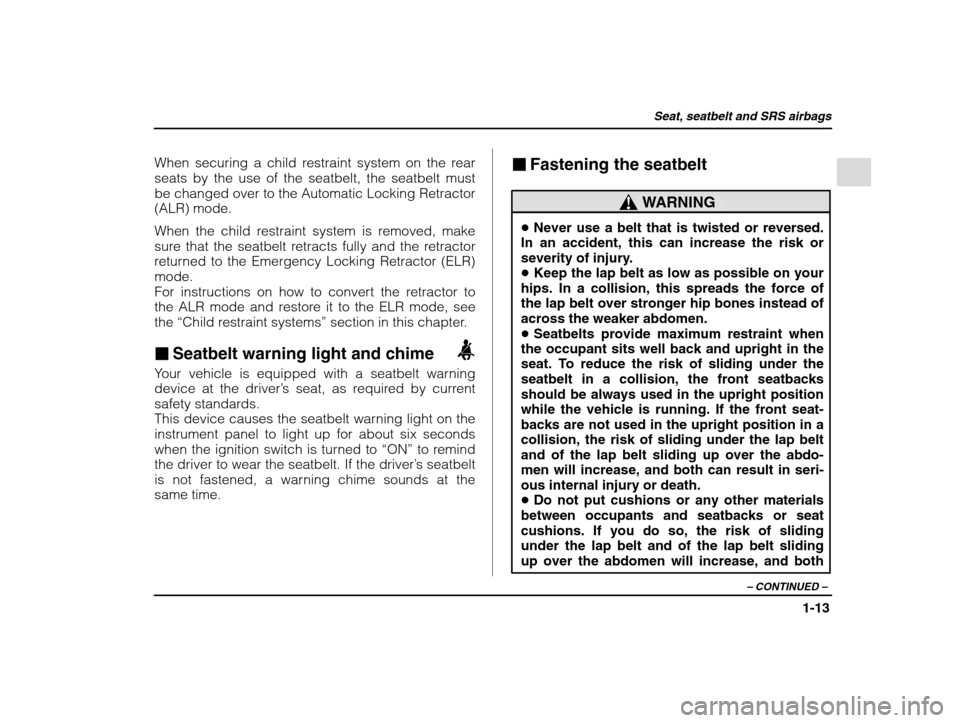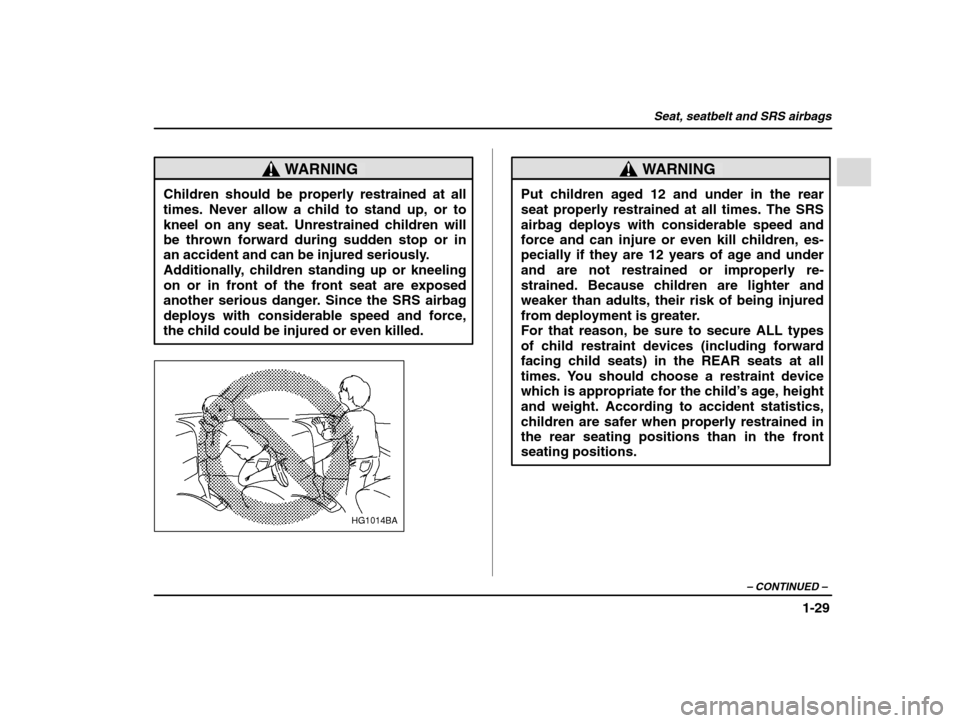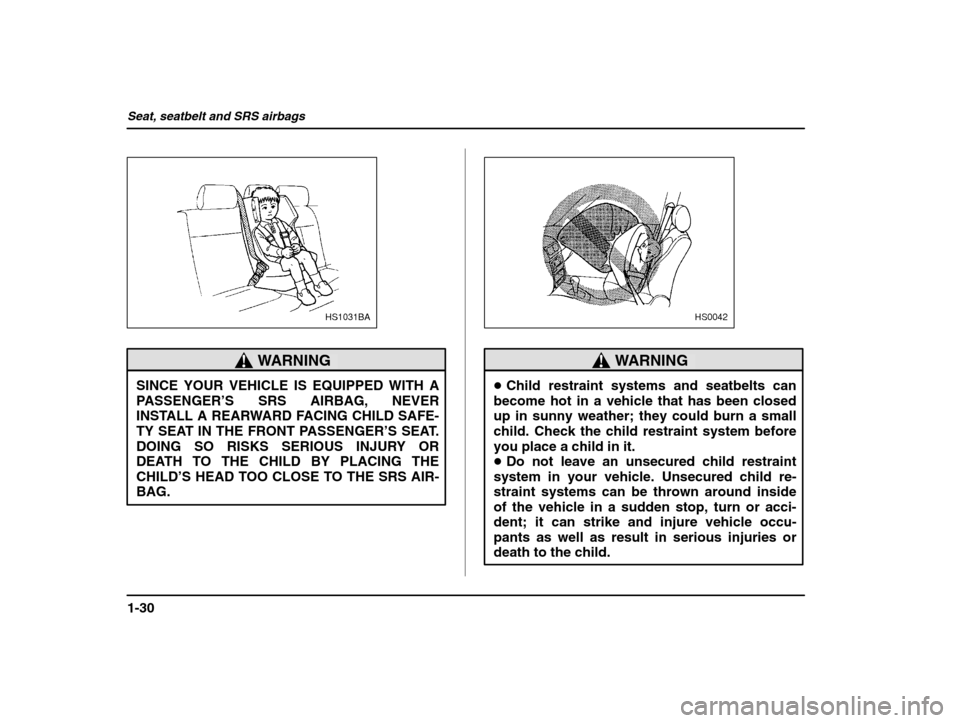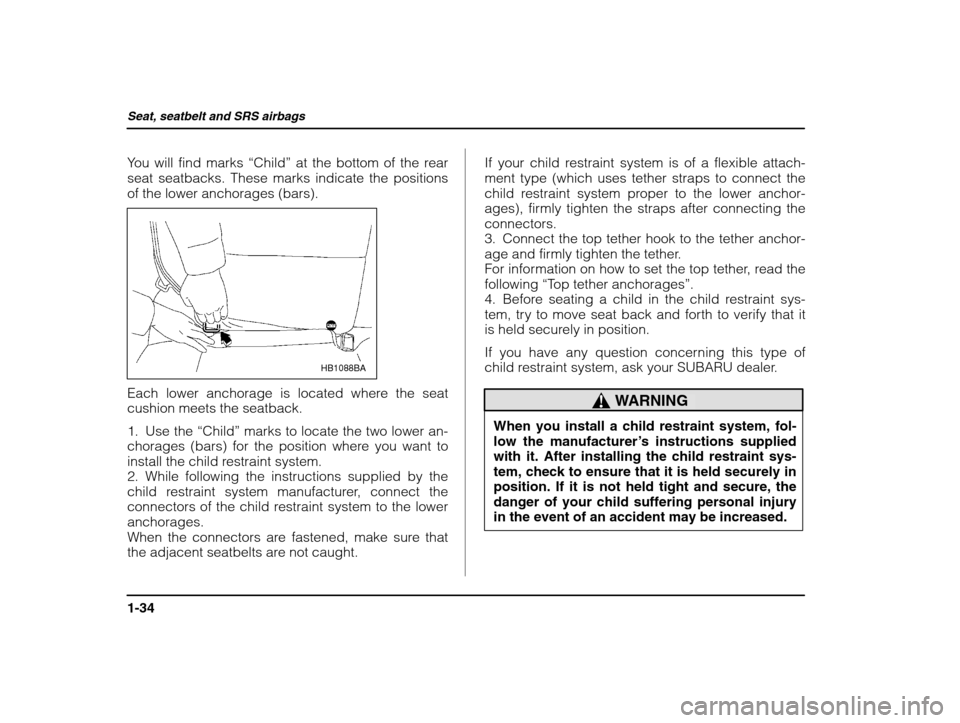2002 SUBARU IMPREZA WRX ECU
[x] Cancel search: ECUPage 36 of 390

Seat, seatbelt and SRS airbags
1-13
– CONTINUED –
When securing a child restraint system on the rear seats by the use of the seatbelt, the seatbelt mustbe changed over to the Automatic Locking Retractor(ALR) mode.
When the child restraint system is removed, make
sure that the seatbelt retracts fully and the retractor
returned to the Emergency Locking Retractor (ELR) mode.
For instructions on how to convert the retractor to
the ALR mode and restore it to the ELR mode, seethe “Child restraint systems ” section in this chapter.
� Seatbelt warning light and chime
Your vehicle is equipped with a seatbelt warningdevice at the driver ’s seat, as required by current
safety standards.
This device causes the seatbelt warning light on the
instrument panel to light up for about six seconds
when the ignition switch is turned to “ON” to remind
the driver to wear the seatbelt. If the driver ’s seatbelt
is not fastened, a warning chime sounds at thesame time. �
Fastening the seatbelt
WARNING
�Never use a belt that is twisted or reversed.
In an accident, this can increase the risk or
severity of injury. � Keep the lap belt as low as possible on your
hips. In a collision, this spreads the force of the lap belt over stronger hip bones instead ofacross the weaker abdomen.� Seatbelts provide maximum restraint when
the occupant sits well back and upright in the
seat. To reduce the risk of sliding under the
seatbelt in a collision, the front seatbacksshould be always used in the upright position
while the vehicle is running. If the front seat-
backs are not used in the upright position in a
collision, the risk of sliding under the lap belt
and of the lap belt sliding up over the abdo- men will increase, and both can result in seri-ous internal injury or death.� Do not put cushions or any other materials
between occupants and seatbacks or seat
cushions. If you do so, the risk of sliding under the lap belt and of the lap belt sliding up over the abdomen will increase, and both
Page 50 of 390

Seat, seatbelt and SRS airbags
1-27
– CONTINUED –
sioner does not operate, contact your SUBARU dealer as soon as possible. �Precautions against vehicle modifica- tion
CAUTION
Do not perform any of the following modifica- tions. Such modifications can interfere with proper operation of the seatbelt pretension- ers.�Attachment of any equipment (bush bar,
winches, snow plow, skid plate, etc.) otherthan SUBARU genuine accessory parts to thefront end. � Modification of the suspension system or
front end structure. � Installation of a tire of different size and
construction from the tires specified on thetire placard attached to the door jamb.
Always consult your SUBARU dealer if you want to
install any accessory parts to your vehicle. Child restraint systems
Infants and small children should always be placed
in an infant or child restraint system in the rear seat
while riding in the vehicle. You should use an infant
or child restraint system that meets Federal Motor
Vehicle Safety Standards or Canada Motor Vehicle
Safety Standards, is compatible with your vehicle
and is appropriate for the child
’s age and size. All
child restraint systems are designed to be secured
in vehicle seats by lap belts or the lap belt portion of
a lap/shoulder belt (except those covered under the section in this manual, entitled “Installation of child
restraint systems by use of lower and tether anchor-
ages”).
Children could be endangered in an accident if their
child restraints are not properly secured in the ve-
hicle. When installing the child restraint system,
carefully follow the manufacturer ’s instructions.
According to accident statistics, children are safer
when properly restrained in the rear seating posi-
tions than in the front seating positions.
Page 52 of 390

Seat, seatbelt and SRS airbags
1-29
– CONTINUED –
WARNING
Children should be properly restrained at all times. Never allow a child to stand up, or tokneel on any seat. Unrestrained children willbe thrown forward during sudden stop or in
an accident and can be injured seriously.
Additionally, children standing up or kneelingon or in front of the front seat are exposed
another serious danger. Since the SRS airbag
deploys with considerable speed and force,the child could be injured or even killed.
HG1014BA
WARNING
Put children aged 12 and under in the rear seat properly restrained at all times. The SRSairbag deploys with considerable speed andforce and can injure or even kill children, es-
pecially if they are 12 years of age and under and are not restrained or improperly re-strained. Because children are lighter and
weaker than adults, their risk of being injured
from deployment is greater.
For that reason, be sure to secure ALL types of child restraint devices (including forward
facing child seats) in the REAR seats at all
times. You should choose a restraint devicewhich is appropriate for the child ’s age, height
and weight. According to accident statistics,children are safer when properly restrained in the rear seating positions than in the front seating positions.
Page 53 of 390

Seat, seatbelt and SRS airbags
1-30
HS1031BA
WARNING
SINCE YOUR VEHICLE IS EQUIPPED WITH A
PASSENGER’S SRS AIRBAG, NEVER
INSTALL A REARWARD FACING CHILD SAFE-
TY SEAT IN THE FRONT PASSENGER ’S SEAT.
DOING SO RISKS SERIOUS INJURY OR
DEATH TO THE CHILD BY PLACING THE
CHILD’ S HEAD TOO CLOSE TO THE SRS AIR-
BAG.
HS0042
WARNING
� Child restraint systems and seatbelts can
become hot in a vehicle that has been closed up in sunny weather; they could burn a small child. Check the child restraint system beforeyou place a child in it.� Do not leave an unsecured child restraint
system in your vehicle. Unsecured child re-straint systems can be thrown around inside of the vehicle in a sudden stop, turn or acci-
dent; it can strike and injure vehicle occu-pants as well as result in serious injuries ordeath to the child.
Page 54 of 390

Seat, seatbelt and SRS airbags
1-31
– CONTINUED –
�Installing child restraint systems with seatbelt
HB1080BA
1. Set the child restraint system in the seating posi- tion.
2. Run the lap and shoulder belt through or around
the child restraint system following the instructions
provided by its manufacturer. If the shoulder belt
goes in front of the child ’s face or neck, put it behind
the child restraint system.
3. Insert the tongue plate into the buckle.
4. Take up the slack in the lap belt.
5. Pull out the seatbelt fully from the retractor to
change the retractor over from the Emergency Lock-ing Retractor (ELR) to the Automatic Locking Re-
tractor (ALR) function. Then, allow the belt to rewind into the retractor. As the belt is rewinding, clicks will
be heard which indicate the retractor functions asALR.
6. Before having a child sit in the child restraint sys-
tem, move it back and forth to check if it is firmly
secured. Sometimes a child restraint can be more
firmly secured by pushing it down into the seat
cushion and then tightening the seatbelt.
7. Pull at the shoulder portion of the belt to confirm
that it cannot be pulled out (ALR properly function-ing).
If the child restraint system requires a top tether,
latch the hook onto the top tether anchor and tighten
the top tether. See the
“Top tether anchorages ” for
additional instructions.
HG0188
Page 55 of 390

Seat, seatbelt and SRS airbags
1-32
HG1033BA
8. To remove the child restraint system, press the
release button on the seatbelt buckle and allow the
belt to retract completely. The belt will return to theELR mode.
If you have any question concerning this type of
child restraint system, ask your SUBARU dealer. NOTE When the child restraint system is no longer in use, remove it and restore the ELR function of
the retractor. That function is restored by allow-
ing the seatbelt to retract fully.
CAUTION
When you install a child restraint system, fol- low the manufacturer’s instructions supplied
with it. After installing the child restraint sys-tem, check to ensure that it is held securely in
position. If it is not held tight and secure, the
danger of your child suffering personal injuryin the event of an accident may be increased.
� Installation of child restraint systems by use of lower and tether anchor-ages
Some types of child restraint systems can be
installed on the rear seat of your vehicle without use
of the seatbelts. Such child restraint systems are se-
cured to the dedicated anchorages provided on the
vehicle body.
Your vehicle is equipped with four lower anchorages
(bars) and three upper anchorages (tether anchor-
ages) for accommodating such child restraint sys-tems.
Page 57 of 390

Seat, seatbelt and SRS airbags
1-34
You will find marks “Child” at the bottom of the rear
seat seatbacks. These marks indicate the positions of the lower anchorages (bars).
HB1088BA
Each lower anchorage is located where the seat
cushion meets the seatback.
1. Use the “Child” marks to locate the two lower an-
chorages (bars) for the position where you want to
install the child restraint system.
2. While following the instructions supplied by the
child restraint system manufacturer, connect the
connectors of the child restraint system to the loweranchorages.
When the connectors are fastened, make sure that
the adjacent seatbelts are not caught. If your child restraint system is of a flexible attach-
ment type (which uses tether straps to connect the
child restraint system proper to the lower anchor-
ages), firmly tighten the straps after connecting theconnectors.
3. Connect the top tether hook to the tether anchor-
age and firmly tighten the tether.
For information on how to set the top tether, read the
following “
Top tether anchorages ”.
4. Before seating a child in the child restraint sys-
tem, try to move seat back and forth to verify that it
is held securely in position.
If you have any question concerning this type of
child restraint system, ask your SUBARU dealer.
WARNING
When you install a child restraint system, fol- low the manufacturer ’s instructions supplied
with it. After installing the child restraint sys-tem, check to ensure that it is held securely in
position. If it is not held tight and secure, the
danger of your child suffering personal injuryin the event of an accident may be increased.
Page 59 of 390

Seat, seatbelt and SRS airbags
1-36
Wagon: There is an anchorage for the center seat-
ing position at the rear end of the ceiling, and
anchorages for each of the two window-side seating
positions on the rear wall of the cargo area.
� To hook the top tether
n Sedan
HGS035BB
F: Front of vehicle
1) Top tether hook
2) Upper anchorage
Fasten the top tether hook of the child restraint sys-
tem to the appropriate upper anchorage.
Tighten the top tether securely. n
Wagon
HGS031BA
1. Remove the headrest at the seating position
where the child restraint system has been installed with the seatbelt or lower anchorages; lift up the
headrest while pressing the release button. Store the
headrest in the cargo area. Avoid placing the head-
rest in the passenger compartment to prevent it from
being thrown around in the passenger compartment
in a sudden stop or a sharp turn.